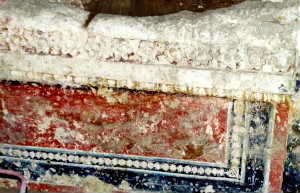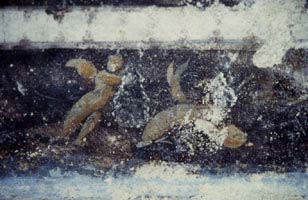GABBARI
An end to hope. Publication
The hopes, based on repeated promises, to see the archaeological site beneath the new Gabbari bridge preserved and opened to the public proved to be short lived. Certainly, a UNESCO mission had proposed solutions that would have allowed the bridge to be built and the majority of the tombs saved, however, on 29 February 2000 the excavation stopped, bulldozers replaced archaeologists and a hundred-odd concrete columns soon punctured the site. This definitive loss has only increased the interest in publishing this salvage excavation.

painted bed, 2nd century BC.
Tomb B26
A first volume covering the tombs B1, B2, B3 and B8 rolled off the IFAO presses in June 2001. A second, under preparation, will present the excavation and the artefacts from two sectors of the dig site as well as studies of the painted decoration. The excavation revealed high quality wall decorations, most notably an extremely well preserved funerary bed cut out of the rock and richly painted, dating from the first half of the 2nd century BC, as well as a painted ceiling from the same period with a frieze of Cupids.

Tomb B24
painted ceiling with frieze of Cupids, 2nd century BC.
The volumes to come will present the other sectors of the excavation as well as studies dedicated to the anthropological examinations with one volume specific to burials and another to creations. These will be complemented by a monograph on the cinerary urns, which, in conjunction with the anthropological analyses, will lay out a history of cremation in Alexandria over six centuries, from the 4th BC to the disappearance of the practice during the first centuries of Roman occupation.